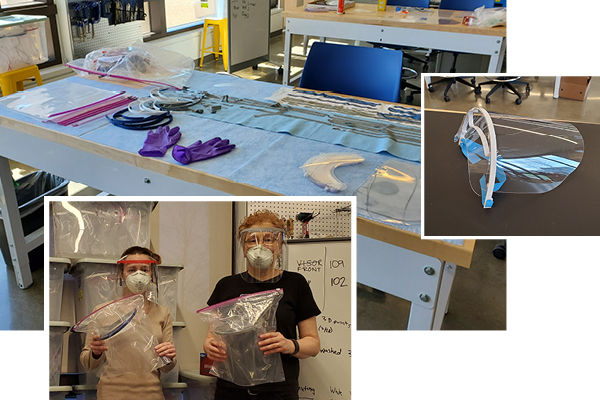Last Word: Remix
When the COVID-19 pandemic reached St. Louis, Charlotte Guertler and Ruth Okamoto worked together in the Spartan Light Metal Products Makerspace to create face shields for health care providers at the School of Medicine

Charlotte Guertler is staff research associate & Makerspace associate director, and Ruth Okamoto is Makerspace director and teaching professor, both in the Department of Mechanical Engineering & Materials Science.
On March 11 we learned our students would complete the spring semester online. A semester and a half after opening, the Spartan Light Metal Products Makerspace was silent. We began to plan for next fall — envisioning improvements and new projects. This was a quiet — and brief — interlude.
Within days, our inboxes filled with requests from the School of Medicine for personal protective equipment. Colleagues and students had seen designs for personal protective equipment posted online. Could we make them? Could we improve them? Our planning morphed to research on face shields, N95 masks, ventilators and more. What was most needed, and how could we help? Our efforts quickly merged into the COVID-19 Maker Task Force. Face shields were needed urgently, and we had the tools to produce them. Numerous designs were available online, but we needed to know if what we built met the needs of medical professionals.
Our Makerspace lights were back on. Each shield became a "remix"— taking the best of existing designs and modifying them. Each new set of 3D printed frames was ready within hours. Plastic shields were laser cut. Endless questions ensued — were the shields wide enough? Long enough? Could they be cleaned? Elastic ran out — could we use a tourniquet strap? Within days, we had several designs ready for clinicians to evaluate. Their feedback led to further remix and eventually a new shield. Then we turned from prototyping to production.
We borrowed additional 3D printers and turned the Makerspace into a mini-factory. We moved tables, cut material, cleaned 3D prints, washed, dried and assembled shields, all while observing social distancing.
Three weeks later, we and our task force partners had made and distributed 950 face shields. The equipment, flexibility and tools of the Makerspace made it possible — remixed for an unexpected and important new purpose.
Back to Engineering Momentum